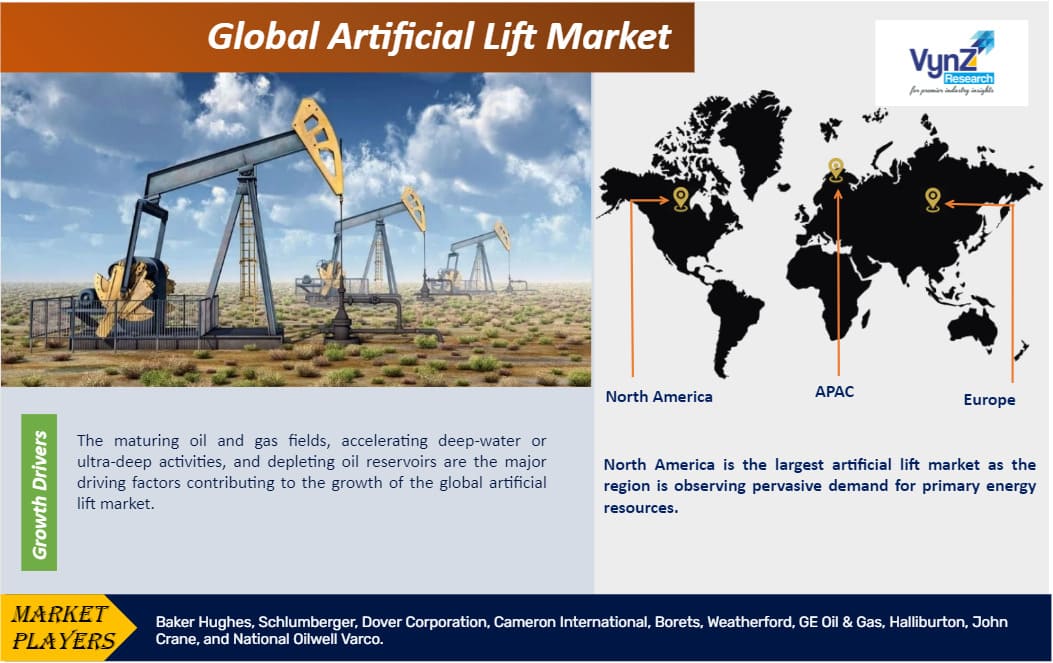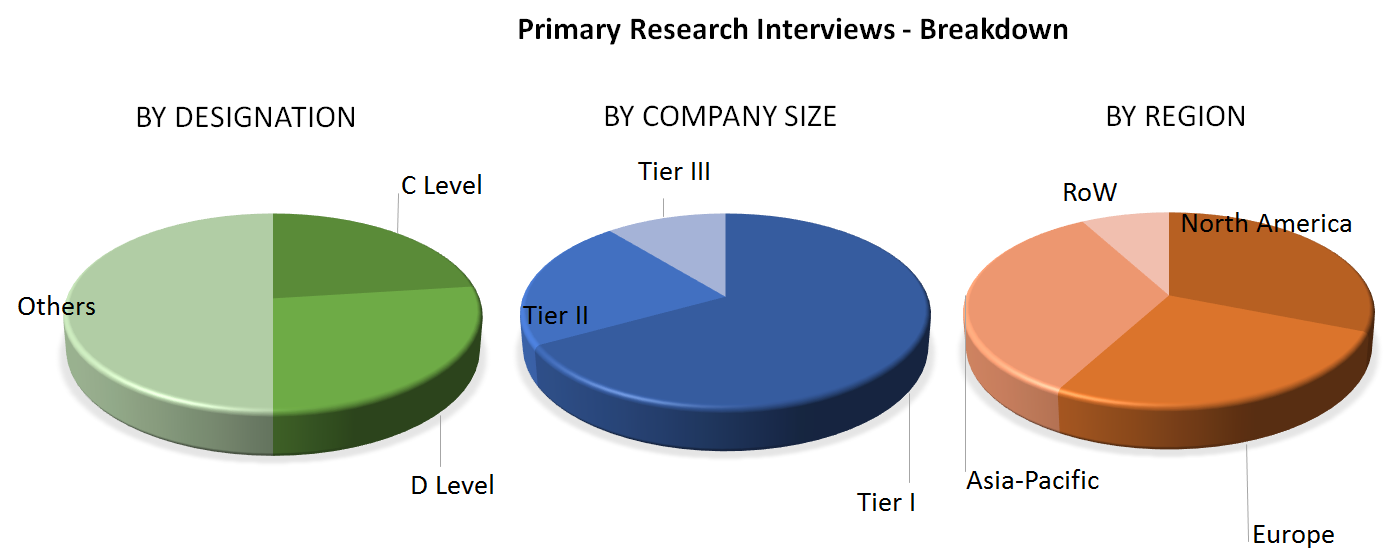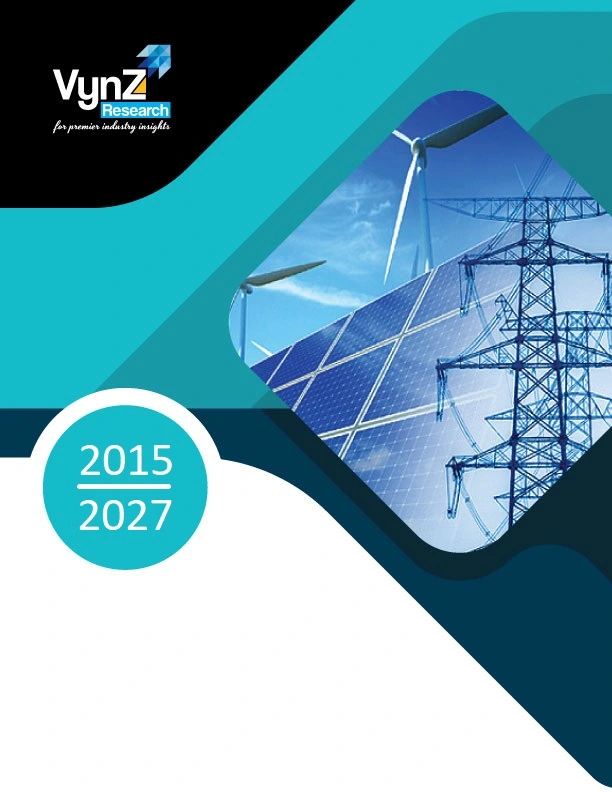Industry Overview
The Global Artificial Lift Market was valued at USD 9.5 billion in 2023 and will reach USD 14.2 billion by 2030.

The market is witnessing significant growth owing to extensive demand for fossil fuels and an escalating number of settled reserves that comprise a large amount of crude oil. Additionally, swelling production capabilities of shale gas and heavy oil are further driving the growth of the artificial lift market globally.
Global Artificial Lift Market Report Coverage
|
Report Metric
|
Details
|
|
Historical Period
|
2018 - 2023
|
|
Base Year Considered
|
2024
|
|
Forecast Period
|
2025 - 2030
|
|
Market Size in 2024
|
U.S.D. 9.5 Billion
|
|
Revenue Forecast in 2030
|
U.S.D. 14.2 Billion
|
|
Growth Rate
|
6.5%
|
|
Segments Covered in the Report
|
By Type, By Mechanism, By Application
|
|
Report Scope
|
Market Trends, Drivers, and Restraints; Revenue Estimation and Forecast; Segmentation Analysis; Impact of COVID-19; Companies’ Strategic Developments; Market Share Analysis of Key Players; Company Profiling
|
|
Regions Covered in the Report
|
North America, Europe, Asia-Pacific, Middle East, and Rest of the World
|
Global Artificial Lift Market Industry Dynamics
Global Artificial Lift Market Trends / Growth Drivers
The maturing oil and gas fields, accelerating deep-water or ultra-deep activities, and depleting oil reservoirs are the major driving factors contributing to the growth of the global artificial lift market. Oil production is observed to be enhanced at a peak rate approximately in 35 countries including some of the major oil producers such as Kuwait and Russia. Moreover, artificial lifts enable the producer to have better control, optimizing the unloading fluid process and performing various activities such as gas injection points without any hindrance and in an efficient manner.
This flexibility in operations achieved by artificial lift is expected to help in fulfilling the future demand for oil and gas manipulation challenges by significantly decreasing gas-lift costs for subsea wells and deep water. All these factors are excessively enhancing the demand for the artificial lift market across the globe.
Global Artificial Lift Market Challenges
The application of artificial lift in horizontal wells is the major challenge for the growth of the global artificial lift market. It has been observed that the artificial lifts are not significant for wells with substantial deviations from vertical wells. The placement of rod pumps and other artificial lift methods in a strayed manner leads to several problems such as high exertion on the reservoir, deprived liquid lift proficiencies due to the intrusion of gas in down-hole pumps and huge operating costs are some of the factors that hinder the growth of artificial lift market globally.
Recent Developments By The Key Players
Baker Hughes has opened its new liquid mud plant, cement bulk and integrated multi-modal complex in Namibia. This facility is the country’s largest liquid mud plant in terms of volume and capacity to support offshore oil and gas operations.
Petronas, via Malaysia Petroleum Management (MPM), has signed memoranda of understanding (MoU) at the ADIPEC event this week in Abu Dhabi with Schlumberger WTA (Malaysia), which relates to improve the technical capabilities of artificial intelligence (AI), machine learning and generative AI technologies. This partnership shall integrate AI-driven solutions into MPM’s data platform, to overhaul management and interpretation of subsurface data which will support the Malaysian offshore operations of emerging Petroleum Arrangement Contractors.
Global Artificial Lift Market Segmentation
VynZ Research provides an analysis of the key trends in each segment of the Global Artificial Lift Market report, along with forecasts at the regional and country levels from 2025-2030. Our report has categorized the market based on type, mechanism and application.
Insight by Type
- Rod Lift
- Electric Submersible
- Progressive Cavity Pumps
- Gas Lift
- Others
Based on type, the global artificial lift market is segmented into Rod Lifts, Electric Submersibles, Progressive Cavity Pumps, Gas Lift, and Other types of artificial lift. Among all the types, rod lift is expected to witness the fastest growth during the forecast period 2025–2030. The rapid growth of rod lift has contributed to enhanced demand in the U.S. and Canada for the unconventional fabrication of oil and shale gas. Rod lifts are considered to be quite an economical and efficient alternative enabling manufacturers to develop consistency in several downhole equipment, which provides enhanced volume and higher deviations in the production process thereby contributing towards the accelerating growth of the global artificial lift market.
Insight by Mechanism
- Pump Assisted
- Gas Assisted
On the basis of mechanism, the artificial lift market is segregated into Pump Assisted and Gas Assisted. Pump assisted lift is further divided into Positive Displacement and Dynamic Displacement. Among these segments, the pump-assisted segment dominated the market during the forecast period due to the rising adoption of progressive cavity pumps and electric submersible pumps. Also technological development plays an important role in the segment's growth.
Insight by Application
The Artificial Lift market is segmented on account of Application into offshore and onshore applications. The offshore segment dominated the market during the forecast period due to an increase in upstream activities pertaining to the deep-water and ultra-deep-water fields.
Global Artificial Lift Industry Ecosystem
Globally industry players in the artificial lift market are leveraging new and innovative artificial lift technologies consolidated with new techniques and processes that enable its users to maximize production capabilities and reduce risk and thus assist shale operators to attain a competitive edge. The providers are continuously implementing low-cost effective lift systems and help the users in attaining optimum production capabilities to flourish in the existing artificial lift market.
Global Artificial Lift Market: Geographic Overview
- North America
- Europe
- Germany
- U.K.
- France
- Italy
- Spain
- Russia
- Rest of Europe
- Asia-Pacific (APAC)
- China
- Japan
- India
- South Korea
- Vietnam
- Thailand
- Malaysia
- Rest of Asia-Pacific
- Rest of the World (RoW)
- Brazil
- Saudi Arabia
- South Africa
- U.A.E.
- Other Countries
Geographically, North America is the largest artificial lift market as the region is observing pervasive demand for primary energy resources such as household activities, transportation, and power generation is expanding the consumption of oil and gas in this region. This is persuading the manufacturers of oil and gas to meet this ever-increasing demand and thereby dig deep, thus leading to accelerating demand for artificial lift in North America.
Moreover, Asia Pacific is expected to witness the fastest growth in the artificial lift market during the forecast period 2025–2030. Countries in this region specifically China and India are estimated to swell the oil and gas demand that is expected to drive the demand for the artificial lift market in this region.
Global Artificial Lift Market Competitive Insight
Increasing opportunities observed by oil and gas producers in the artificial lift market and the development of mature fields are encouraging the manufacturers to rapidly adopt this system and provide cost efficiency and steady performance to their customers.
The Artificial Lift Market report offers a comprehensive market segmentation analysis along with an estimation for the forecast period 2025–2030.





